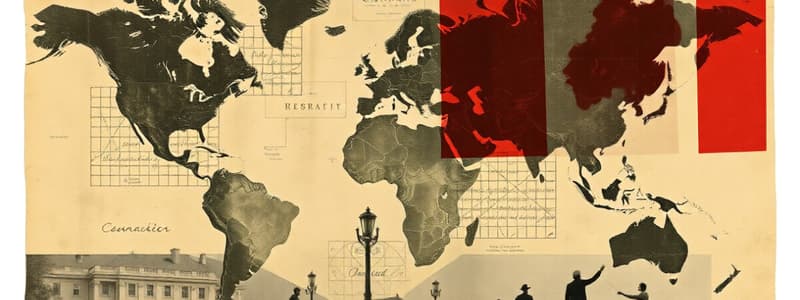Podcast
Questions and Answers
What is the main purpose of refugee protection under Canadian immigration policy?
What is the main purpose of refugee protection under Canadian immigration policy?
- To safeguard individuals from economic challenges in their home country
- To protect individuals seeking refuge from persecution (correct)
- To grant temporary vis to individuals for educational purposes
- To provide permanent residency to selected individuals
Which process involves evaluating an applicant's qualifications under specified criteria?
Which process involves evaluating an applicant's qualifications under specified criteria?
- Security Checks and Background Investigations
- Eligibility Assessment (correct)
- Medical Examinations
- Application Submission and Processing
What procedural rights do applicants have during the immigration process?
What procedural rights do applicants have during the immigration process?
- The right to remain in Canada indefinitely during processing
- The right to a legal representative at all times
- The right to be heard and to an unbiased decision-making process (correct)
- The right to immediate resolution of their application
How do immigration policies impact Canadian society?
How do immigration policies impact Canadian society?
What takes place during medical examinations in the immigration process?
What takes place during medical examinations in the immigration process?
What does IRPA primarily establish for immigration in Canada?
What does IRPA primarily establish for immigration in Canada?
Which immigration category under IRPA focuses on attracting skilled individuals?
Which immigration category under IRPA focuses on attracting skilled individuals?
How does the IRPR differ from the IRPA?
How does the IRPR differ from the IRPA?
What does the IRPR specify regarding applicants?
What does the IRPR specify regarding applicants?
Which statement accurately describes IRPA's role?
Which statement accurately describes IRPA's role?
Which of the following is NOT a subcategory of economic immigrants under IRPA?
Which of the following is NOT a subcategory of economic immigrants under IRPA?
What is one key aspect addressed by both IRPA and IRPR?
What is one key aspect addressed by both IRPA and IRPR?
Which of the following is true regarding the categories of immigration under IRPA?
Which of the following is true regarding the categories of immigration under IRPA?
What should you do to ensure your case is treated fairly in the proceedings?
What should you do to ensure your case is treated fairly in the proceedings?
How should you address any procedural issues that arise during the case?
How should you address any procedural issues that arise during the case?
What is the importance of following hearing etiquette during proceedings?
What is the importance of following hearing etiquette during proceedings?
Which aspect is crucial for a successful presentation of your case?
Which aspect is crucial for a successful presentation of your case?
What should you prioritize when presenting arguments during proceedings?
What should you prioritize when presenting arguments during proceedings?
Flashcards
Permanent Resident
Permanent Resident
An individual who is granted long-term status in Canada, giving them the right to live and work permanently.
Temporary Resident
Temporary Resident
An individual who is granted temporary authorization to be in Canada for a specific purpose and duration. Examples include student visas and work permits.
Eligibility Assessment
Eligibility Assessment
A process where an applicant's qualifications and background are assessed against specific criteria to determine their eligibility for immigration to Canada.
Medical Examination
Medical Examination
Signup and view all the flashcards
Procedural Rights and Safeguards
Procedural Rights and Safeguards
Signup and view all the flashcards
What is IRPA?
What is IRPA?
Signup and view all the flashcards
What are the IRPR?
What are the IRPR?
Signup and view all the flashcards
What are Economic Immigrants?
What are Economic Immigrants?
Signup and view all the flashcards
What are Family-Sponsored Immigrants?
What are Family-Sponsored Immigrants?
Signup and view all the flashcards
What's the relationship between IRPA and IRPR?
What's the relationship between IRPA and IRPR?
Signup and view all the flashcards
How do the IRPA and IRPR differ in their focus?
How do the IRPA and IRPR differ in their focus?
Signup and view all the flashcards
What are some categories of immigration under the IRPA?
What are some categories of immigration under the IRPA?
Signup and view all the flashcards
How does the IRPA assess immigration applications?
How does the IRPA assess immigration applications?
Signup and view all the flashcards
Evidence and Witness Information
Evidence and Witness Information
Signup and view all the flashcards
Prepare Thoroughly
Prepare Thoroughly
Signup and view all the flashcards
Address Procedural Issues
Address Procedural Issues
Signup and view all the flashcards
Follow Hearing Etiquette
Follow Hearing Etiquette
Signup and view all the flashcards
Understand Applicable Laws
Understand Applicable Laws
Signup and view all the flashcards
Study Notes
Introduction to IRPA and IRPR
- IRPA stands for the Immigration and Refugee Protection Act. It is a Canadian law governing immigration and refugee claims.
- IRPR stands for the Immigration and Refugee Protection Regulations. The regulations detail how the Act is applied.
- IRPA is the main legislative framework, outlining general principles and rights regarding immigration and refugee status.
- IRPR defines procedures, eligibility criteria, and processes for different immigration and refugee pathways.
Key Aspects of IRPA
- It establishes the framework for immigration and refugee protection in Canada.
- It outlines immigration and refugee policies' goals, including attracting skilled workers, family reunification, and protecting vulnerable people.
- It includes categories like economic immigrants, family-sponsored immigrants, and refugees.
- It defines the process for assessing applicants' eligibility for immigration or refugee status.
- It explains grounds for application refusal and the appeals process.
- It addresses the rights and responsibilities of immigrants and refugees.
Key Aspects of IRPR
- It provides detailed rules and procedures for applying IRPA.
- It outlines timelines and requirements for the immigration and refugee application process.
- It details requirements and eligibility criteria for various immigration categories.
- It defines the process for processing and assessing claims.
- It specifies procedural safeguards and applicant rights.
- It outlines consequences for non-compliance.
Key Differences
- IRPA sets broad policies; IRPR provides specific rules for implementation.
- IRPA is general and abstract; IRPR is concrete and procedural.
- IRPA is the overarching framework; IRPR are the operational guidelines.
Overview of Immigration Categories (under IRPA)
- Economic Immigrants: Attract skilled workers, investors, entrepreneurs, and self-employed to meet labour market needs.
- Family-Sponsored Immigrants: Allows immigration based on family relationships (spouse, child, parent, grandparent).
- Refugees: Protects those seeking refuge from persecution or fear of persecution in their home country.
- Permanent Residents: Individuals with long-term status allowing permanent residence.
- Temporary Residents: Individuals with temporary visas (e.g., student, work visas).
Key Immigration Processes (under IRPA/IRPR)
- Application Submission and Processing: Specific steps for submitting and processing applications.
- Eligibility Assessment: Evaluating applicant qualifications based on criteria.
- Medical Examinations: Health assessments to ensure no public health risks.
- Security Checks and Background Investigations: Measures for national security.
- Interviews and Hearings: Opportunities for applicants and authorities to present evidence.
- Evidence and Witness Information: Submitting evidence and witness information on time is crucial.
- Document Preparation: Thoroughly prepare documents, witnesses, and arguments.
- Procedural Issues: Address procedural issues (e.g., interpreter, location) promptly.
- Hearing Etiquette: Follow hearing etiquette and remain truthful and clear during proceedings.
Procedural Rights and Safeguards
- Applicants have procedural rights (e.g., right to be heard, unbiased decisions).
- Procedures ensure fairness and transparency in immigration and refugee decisions.
Impact on Canadian Society
- IRPA and IRPR shape Canada's immigration profile.
- They support economic growth through skilled worker immigration.
- They contribute to Canada's multiculturalism.
- They impact social fabric, community development, and the labour market.
Studying That Suits You
Use AI to generate personalized quizzes and flashcards to suit your learning preferences.


